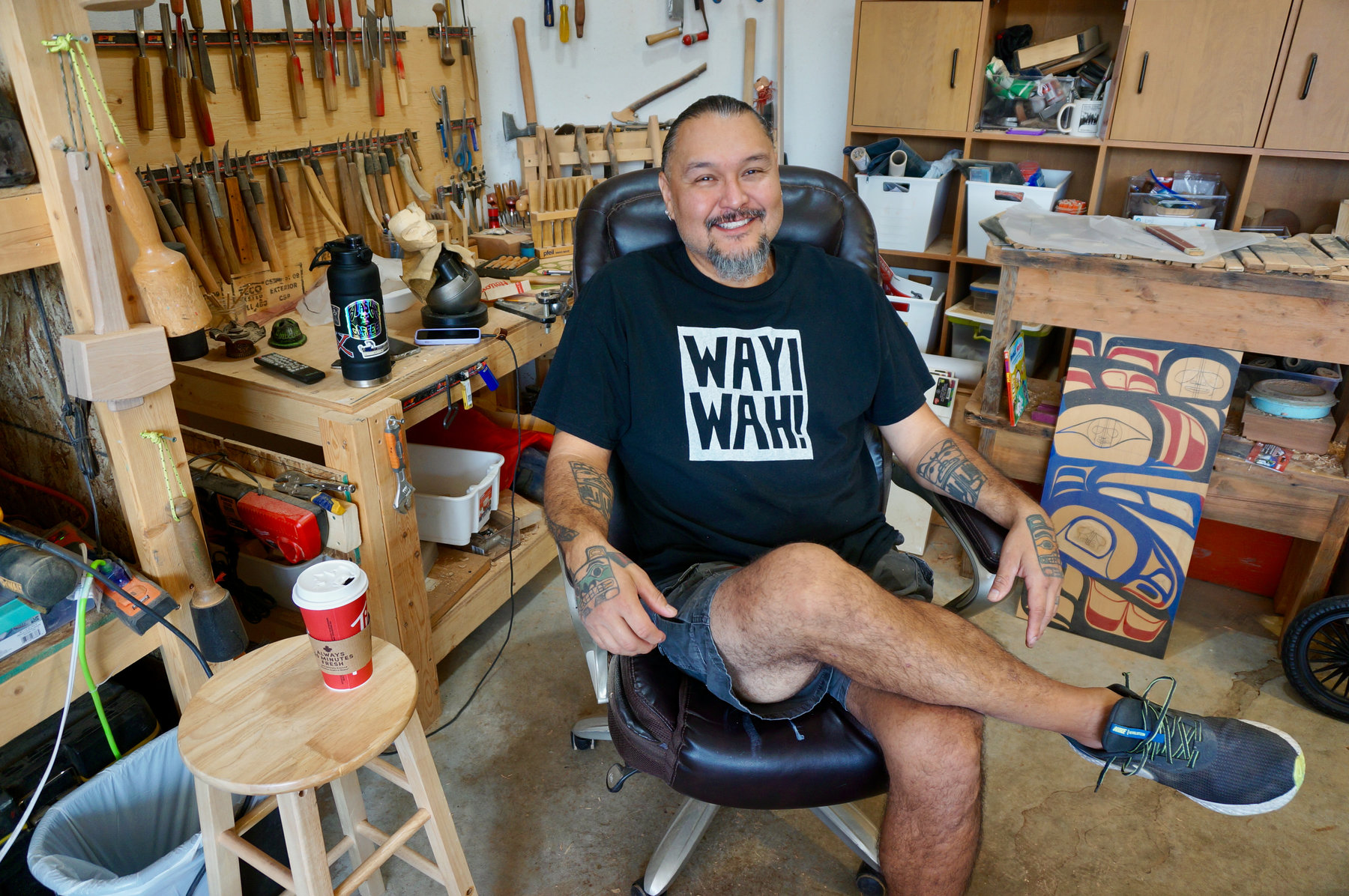
Artikel
08
april
Breathing Lives into Wood
The Western redcedar can reach a height of two hundred feet, and live a thousand years. Ranging from the coastal forests of Northern California to the Alaska Panhandle, these “trees of life” are believed to be sacred, a gift from the Great Spirit to the Indigenous, or First Nations, people of the Pacific Northwest. With a staggering 368 documented uses—from antibiotic properties to a source of fabric dyes—the redcedar is seen by the First Nations as a symbol of the eternal.
 100vw, 202px” /><figcaption id=) The roughed-out Drummer on this totem pole-in-progress is one of three figures representing past, present, and future. A close look reveals a hole in the Drummer’s left hand, which will be used to hold a drumming stick—much like the one Dangeli uses in the video at the end of this article.
The roughed-out Drummer on this totem pole-in-progress is one of three figures representing past, present, and future. A close look reveals a hole in the Drummer’s left hand, which will be used to hold a drumming stick—much like the one Dangeli uses in the video at the end of this article.For Nisga’a artist and craftsman Mike Dangeli (Dan’jelli), the redcedar is central to his work. Dangeli is one of several hundred living Indigenous craftsmen in the Pacific Northwest who have both the skill and standing to create one of the most powerful and recognizable symbols of their traditional culture: totem poles.
“The cedar tree is such an important being amongst our people,” says Dangeli, “that it has two names: Amg?a?n (good wood) and Smg?a?n (real wood).” The Nisga’a people’s uses for this tree run from totem poles to houses, masks, even clothing–as Dangeli puts it, “for everything under the sun.”
Dangeli lives in Chilliwack, a small town about 90 minutes east of Vancouver, British Columbia, along the bright Fraser River. With its sports field, malls, and pizza joints, Chilliwack feels very much like any suburb. On a recent visit, I found Dangeli in his studio, a converted garage behind a trimmed lawn near the outskirts of town.
Dangeli, 50, is a tall man with a graying goatee and tribal tattoos illuminating both arms. A former paratrooper with the U.S. Army Airborne Rangers, he has an easy smile and a direct, unhindered gaze. Dangeli has three children, ages 3 to 31; his wife Mique’l, the mother of his youngest, was the first Indigenous woman to receive a Ph.D. in First Nations Art History.
Although totem poles have long been part of First Nations’ traditional stories, little is known about their origin. The first written record of one—“a large tree… carved all the way up and down”—was made by American sailor John Bartlett, who visited the Pacific Northwest’s Haida village of Dadans in 1790. But if some ancient Indigenous people did indeed migrate into North America over the Bering Strait, the poles Dangeli is carving may share a lineage with the 9,500-year-old Shigir Idol: a 9-foot carved pole which, discovered in Russia’s Ural Mountains in 1890, is the only surviving wooden artifact from the Stone Age.
Tirelessly active, Dangeli often carves late into the night. But we cut a deal: He’ll rouse himself for our morning interviews if I bring him a strong coffee and an old-fashioned doughnut.
Before our first conversation begins, Dangeli sets the cup of coffee on his workbench. “I should do a proper introduction,” he says with formality. He straightens up, hands on his knees, and delivers a rhythmic, melodic proclamation in a language full of hard consonants.
 100vw, 980px” /><figcaption id=) Dangeli and his wife, Mique’l, sat on this “chief’s seat” during their wedding potlatch. Mike’s crest—the beaver—appears on the settee’s back, while the sides portray eagles, Mique’l’s crest. The masks scattered nearby were originally carved for their son Hayetsk, and now have a second life as danceable masks.
Dangeli and his wife, Mique’l, sat on this “chief’s seat” during their wedding potlatch. Mike’s crest—the beaver—appears on the settee’s back, while the sides portray eagles, Mique’l’s crest. The masks scattered nearby were originally carved for their son Hayetsk, and now have a second life as danceable masks.“What I’ve said, in the language spoken amongst the Nisga’a, is this: I’ve thanked the territory that we’re on, the unceded territory whose colonial name is Chilliwack. I said I am a descendant of the Beaver Clan, from the Village of Gingolix, and I’ve given my English name and my Nisga’a name, which means ‘Heart of the Beaver House.’ Just like my name states, I’m in the middle of things—and just like a heart, I keep things moving and pumping within my family, and within our feast potlatch system.”
“Finally, I thanked you for being here today. And thanks for the coffee, for sure!”
Reviving a Forbidden Craft
Brushing off a chair, I take in the ordered chaos around me. The floor and work tables are salted with sawdust. Power tools and chisels are aligned on every horizontal surface. Dangeli’s work-in-progress—10 feet long and about 2 feet in diameter—rests on sawhorses made of heavy beams, alongside a two-ton crane. It’s his 29th pole.
“The act of pole-carving is a declaration of who we are,” says Dangeli. “It conveys the idea that we are continuing to practice our ancient ways of knowing and being.” Equally important, he says, is the history it embodies: the ceremonies and songs that go with a pole’s raising. “Because not so long ago—within my Mom’s generation—it was against the law for us to do these things.”
Dangeli is referring to the “potlatch ban.” Between 1885 and 1951, many First Nations rituals were prohibited by the Canadian government. These included formal community gatherings known as potlatches (yaawk in the Nisga’a/Tsimshian language), and the raising of poles, activities that Canadian authorities considered inconsistent with “a European mindset.” Innumerable totem poles from all over Canada—primarily the Pacific Northwest—were subsequently pulled down, eventually becoming valued prizes for museums and collectors. Purloined totem poles can fetch high prices on the tribal arts market (many of Dangeli’s are underwritten by grants). As recently as 2013, one was auctioned off to a British art collector for more than $30,000. [See our sidebar, “Preservation or Exploitation?“]
Totem Poles for Justice
Dangeli uses his work to embody the whole of his lived experience, and the experience of his lineages. There are spiritual forces at play here for him, and undercurrents of generational trauma. All inform his craft. Raising a pole, Dangeli says, often commemorates a singular event within the community—to mark when someone receives a chief’s name, or as a memorial to somebody who has passed.
“You know…,“ Dangeli says, shaking his head, “People still think, in the twenty-first century, that we worship these totem poles. But they’re not about worshiping. They’re about honoring ancestors, and honoring histories.”
One tragic—and ongoing—period of First Nations history is occurring on a desolate section of the Trans-Canada Highway, which wobbles across northern British Columbia from Prince George to Prince Rupert (on the Pacific coast) and has become known as the “Highway of Tears.” Over the years, scores of women and girls—many from First Nations communities—have vanished along this 430-mile stretch of road. The official count of victims varies, but some locals put the number in the thousands. The remains of some women have been found; others are still missing.
 100vw, 980px” /><figcaption id=) “If you were to look under a microscope, at the grain of the wood, the rings are actually what we carve,” Dangeli says. In between the rings is a material that looks like cork. When redcedar dries, it gets harder to carve. Spraying the surface of the wood, as Dangeli is doing here, causes the rings to swell. This makes carving easier.
“If you were to look under a microscope, at the grain of the wood, the rings are actually what we carve,” Dangeli says. In between the rings is a material that looks like cork. When redcedar dries, it gets harder to carve. Spraying the surface of the wood, as Dangeli is doing here, causes the rings to swell. This makes carving easier.The series of abductions, which started in the 1950s, has inspired a Canada-wide campaign called “Missing and Murdered Indigenous Women” (MMIW). While not widely known among non-Indigenous people living south of the Canada/U.S. border, the situation is very familiar to Canadians.
The pole Dangeli is carving during my visit—and the still-rough log of Western redcedar he’ll carve next—are designed to mark this tragedy, to raise public awareness, and to give voice to the MMIW. (Note: The acronym is sometimes expanded to MMIWG2S, adding girls and LGBTQ persons whose identity is sometimes recognized as Two-Spirited.)
One of several purposes that totem poles serve is to symbolize the re-taking of territory—land where First Nations people can again share long-forbidden songs, dances, foods, and rituals.
For Dangeli, the cause is both political and personal. “Highway 16 cuts through my home in the village of Kitsumkalum, near Terrace,” he says. “A number of our own family have gone missing. And the government and RCMP [Royal Canadian Mounted Police] have done very little about it.”
Initially, a number of the families and survivors wanted Dangeli’s new pole to go on the highway itself—”but then it would just be something that people drive by,” he says. That location would also make it subject to defacement and graffiti. It was finally raised in Kitsumkalum, BC, where the highway cuts through Tsimshian Territory.
Dangeli is making these poles to serve two additional purposes. One is to remember the survivors of Canada’s residential schools. Christian-run and government-funded, these schools were another grim example of oppression—an attempt at what Canada now admits was “cultural genocide.” Between the 1870s and 1990s, some 150,000 Indigenous children were taken from their villages and placed into these boarding schools. According to CBS News, more than 3,000 children in the schools “died from disease due to overcrowding, malnutrition and poor sanitation, or died after being abused or trying to run away.”
The poles’ other purpose is to symbolize the re-taking of territory—land where First Nations people can again share long-forbidden songs, dances, foods, and rituals.
Regardless of where his poles are placed, or which meaning onlookers glean from them, Dangeli hopes they serve as a place that bereaved kin can visit—“a safe and sacred space to share songs, offer prayers, and leave offerings for the people that are missing.”
 100vw, 980px” /><figcaption id=) This plastic circle template will help Dangeli carve the Matriarch’s eyes, and make sure they’re the same diameter. “It’s just a great tool. I am a traditionally contemporary artist, so I use every tool I can in the twenty-first century.”
This plastic circle template will help Dangeli carve the Matriarch’s eyes, and make sure they’re the same diameter. “It’s just a great tool. I am a traditionally contemporary artist, so I use every tool I can in the twenty-first century.”Breathing Objects to Life
As clear as a carver’s vision may be, there comes a time to “back off,” as Dangeli puts it, “and let the pole tell you what it wants to be.” This is critical because, when raised, the pole will be considered a being in its own right.
In the Sm’algyax language—of which Nisga’a and Tsimshian are dialects—the word noxnox (nok-nok) means “ceremonial beings beyond human power.” It’s rooted in the First Nations belief that seemingly inanimate objects are already alive, and can be imbued with spiritual power. Totem poles radiate noxnox, as do tribal dance and potlatch regalia: drums and dresses, jewelry and masks, headdresses, and bentwood boxes.
This life energy, Dangeli argues, is transferred with the breath. “When we wear our masks—say, if I’m dancing as an eagle—I’m not dancing the mask: the mask is actually dancing me,” says Dangeli. “Because when we share our breath, we breathe life into these objects. We do it with totem poles, we do it with drums, we do it with all our ceremonial regalia. Sometimes it’s through dance, sometimes it’s through song, but it’s always through breath. We have a symbiotic relationship with this noxnox: It needs us, and we need it to perform our ceremonies.”
 100vw, 980px” /><figcaption id=) This small figure of “Mouse Woman” was begun by Dangeli’s eldest son, Michael, during a visit, and will be placed atop Dangeli’s next pole. “I’m going to do a little bit of cleanup,” Dangeli says, “add myself to it, and then paint it up.”
This small figure of “Mouse Woman” was begun by Dangeli’s eldest son, Michael, during a visit, and will be placed atop Dangeli’s next pole. “I’m going to do a little bit of cleanup,” Dangeli says, “add myself to it, and then paint it up.”For the Two-Spirited
Chilliwack lies inland from the Canadian coast, a geographic leap from Dangeli’s maternal home in northern British Columbia. He recalls riding the Alaska ferry with his mother and grandmother during his childhood, traveling from Prince Rupert northwest to Skagway, listening to their stories. Both were artisans as well as storytellers, and Mike’s natural gifts for drawing and craftwork took root under their tutelage. “I started by learning how to draw,” he says, “and I did a lot of leather, weaving, and beadwork.” They’d sell their pouches and other handicrafts at ferry stops along the way.
He also learned and practiced traditional Native American dance, which would become another defining part of his life [see our sidebar, “Regalia for All Seasons“]. While living in Aberdeen, Washington, in the 1970s, Dangeli became a member of a dance group brought into schools to teach First Nations children about their living culture—“because everybody thought we were going the way of the dinosaurs.”
Dangeli’s first major work spotlighting the MMIW was a 32-foot totem pole raised in Kitsumkalum, in Western B.C., in 2020. By then, he was also an accomplished songwriter and performer—and for the raising of this pole, he choreographed an Eagle Dance. “That pole was an eagle and a bear, which is one of my wife’s crests and one of my crests. The song we sang talks about the history of that day. And every time we perform, I share that history.”
The 10-foot totem pole Dangeli is working on now is so big the end almost pokes out of his garage. “This pole and the next—which will be my thirtieth—are seen as sisters of the grandmother pole we raised in 2020.”
For the pole-in-progress, the base figure is neither animal nor ancestor. Instead it looks like a bentwood box, another Nisga’a tradition. Made of steamed and hand-bent cedar, these large, colorfully painted chests are used to hold ceremonial regalia. “Yes. A box of treasures,” Dangeli says. “It’s about storing and sharing all of our knowledge, ready to be opened and used by future generations.”
Dangeli is adamant about correcting a familiar misnomer: the “low man on the totem pole” insult. “It’s not true,” he says. “It’s actually the most important figure, because it carries all the weight of the pole.”
Of Chisels and Chainsaws
Prepping a tree for carving is a craft in itself. After a redcedar trunk arrives, Dangeli has to lower it onto industrial-strength supports, scrape off the bark, hollow out the log (removing any rot), then use a laser level and an electric planer to make the pole as square and flat as he can.
The hundreds of chisels, knives, and adzes scattered semi-randomly through Mike’s working area, most with blades of honed steel, have an international pedigree. He’s bought and been gifted hand tools from carvers around the world.
“You’re more than welcome to pick them up,” he offers. “Just be careful.” Wise words; Many are sharp enough to shave with. All are cut and angled a bit differently, allowing specific kinds of trimming, shaping, and detail work. Some have handles of moose antler or polished wood. “And here,” Mike says, “are some bone-handled ones Mique’l gave me for our wedding.”
 100vw, 980px” /><figcaption id=) Dangeli created this piece with his wife when they were working in Inami, Japan, representing Canada for an International Carving Expo. “It was my wife’s birthday,” Dangeli says. “I was working on my pole, and wanted to do this as a way of relaxing.” On the drum is an eagle—his wife’s crest—and inside the head of the eagle is a beaver, Dangeli’s crest. “That’s me and my wife.”
Dangeli created this piece with his wife when they were working in Inami, Japan, representing Canada for an International Carving Expo. “It was my wife’s birthday,” Dangeli says. “I was working on my pole, and wanted to do this as a way of relaxing.” On the drum is an eagle—his wife’s crest—and inside the head of the eagle is a beaver, Dangeli’s crest. “That’s me and my wife.”“How close,” I ask, “are the tools you use now to the ones that were used by First Nations artists three centuries ago?”
“Back then,” he says, “most of the tools were bone and stone. I’ve used obsidian, which cuts like a carving knife. For getting in your ‘V’ cuts and for planing, it does a beautiful finish. I’ve also used beaver-tooth chisels on some smaller, lighter pieces.”
For the pole in progress, Dangeli has defined three distinct levels: the bentwood box; three human figures in a semicircle; and above them a Matriarch, which he normally begins shaping with an adz. In the course of his work and travels, another Indigenous craftsman once suggested he try using a small chainsaw for rough cutting. After he got one (called a pruner), it became one of his favorite tools.
“I get into arguments about it all the time,” he says. “I mean, when does something become ‘traditional’? If I tell people I’m using one of the cast iron skillets I inherited from my grandmother, nobody bats an eye. But I say ‘chainsaw’ and, as an Indigenous artist, I get that chuckle, you know?
Though purists or outsiders might see it as sacrilege for an Indigenous artist to use these tools, Mike has no qualms about combining traditional hand tools with current technology. “Using twenty-first-century tools doesn’t make the work less authentic,” he says. “What sense does that make? If I were out here using stone and bone, this pole would take me a year or two. Did you come here on a horse and buggy?”
As it happens, it was Mike’s grandfather who bought him his first chainsaw. “From Sears and Roebuck, in Prince Rupert.” Dangeli fires up the pruner, and a thin whine fills the air. “I really think,” he shouts, “that all these tools—as we work with them—become ‘traditional.’”
Power tools may save a lot of time, but they also take a toll on the body. While carving some poles, Dangeli has to spend hours icing and heating his hands and forearms before moving on to the next figure. [See Dangeli demonstrate his techniques in our brief video, “The Totem Pole Carver.”]
Followed by the Eyes
“I see myself as a historian,” Dangeli tells me at one point. “To do this work, I had to learn my people’s history. And now the story you write also becomes part of that history.”
After chewing on that for a bit, I ask if he’ll use natural pigments for the pole’s figures. “I have, but they don’t last very long,” he says. “So I use acrylic,” he says. “It seems to hold up better.”
One test of Dangeli’s skill will be the Matriarch’s eyes. For his very first pole in Kitsumkalum, Dangeli was challenged to carve the eyes so that when people drove by, it would look like the totem pole’s eyes were following them. He achieved this by making the eyes unusually round and bulbous. “The one thing everybody kept saying through the whole day is, ‘I feel like it’s watching me.’ And I said, ’It is!’”
 100vw, 819px” /><figcaption id=) A pole-raising ceremony, with eagle down, for one of Mike’s creations on Prince Rupert Island in October 2013. His middle son, Nick, stands next to him, with Mique’l on the other side. “What we’re doing is blessing the totem pole, and then scattering the eagle down to breathe life into it.” photo courtesy of © Mike Dangeli
A pole-raising ceremony, with eagle down, for one of Mike’s creations on Prince Rupert Island in October 2013. His middle son, Nick, stands next to him, with Mique’l on the other side. “What we’re doing is blessing the totem pole, and then scattering the eagle down to breathe life into it.” photo courtesy of © Mike Dangeli“The Only Color Spirits Can See”
When this totem pole is painted, the sanded surfaces of the bentwood box will be covered with designs in formline: the signature style of Pacific Northwest First Nations art.
The technique is defined by clean black borders that curve, thin, and swell, creating bold outlines of birds, whales, bears, beavers, or any of the creatures an artist may wish to portray. Primary colors accent the figures, all of which possess a fierce animism. And as with other ancient arts—from Tibetan thangkas to Japanese ceramics—the more a craftsman understands the traditions, the more complex and abstract they can become.
Near the top of Dangeli’s current totem-pole project will be the figure of a woman, in a dance robe he will inlay with one-inch diameter mirrors. The mirrors will speak to the theme of creating a safe and sacred space for families of murdered and missing Indigenous women.
Above the bentwood box that forms the pole’s base, Dangeli is carving three human figures: a male artist, a central female, and a Two-Spirited drummer. The artist’s and drummer’s shirts will be painted orange, the color chosen in 2013 to commemorate the victims and survivors of Canada’s residential schools. The hand of the non-binary drummer will hold a striking stick. A rainbow will arc across their drumhead, symbolizing a Pride flag—an affirmation of Dangeli’s conviction that all love is sacred.
Between the orange-clad artist and drummer stands a female; her dress will be painted red. This, too, carries special significance. Since 2010, when Métis artist Jamie Black honored the missing and murdered with a powerful museum installation of empty red dresses, the color has become synonymous with the cause.
“It is said that red is the only color spirits can see,” explains Vanessa Brousseau, an Inuit and Ojibwe artist, in a TikTok video. “The red dress represents a calling back to the spirits of these women; allowing them a chance to be among us and have their voices heard through family members and community.”
For the uppermost figure on the pole—the Matriarch—Dangeli plans something unusual: Her dance robe will be inlaid with one-inch diameter mirrors. These will speak to the theme of creating a safe and sacred space for families of the MMIW. Dangeli sees them as a talisman against violence. “If people catch a glimmer of their reflection, they’ll perhaps be more cognizant of how they’re acting. Maybe somebody will say, ‘Oh gosh, I can see myself’—and they won’t hurt somebody.”
 100vw, 980px” /><figcaption id=) Traditional bentwood boxes are one of many ways that Dangeli’s people put redcedar to use. “Redcedar is perfect for the outdoors, because it has natural oils,” he says. “That’s why cedar decking and shingles that you see on homes last for decades.”
Traditional bentwood boxes are one of many ways that Dangeli’s people put redcedar to use. “Redcedar is perfect for the outdoors, because it has natural oils,” he says. “That’s why cedar decking and shingles that you see on homes last for decades.”Cell Phone Towers on the “Highway of Tears”
On September 21st—the autumnal equinox of 2005—the weather in Prince Rupert was cool and breezy: a good day for hitchhiking. Tamara Chipman, 22, a dark-haired, outdoorsy First Nations woman whose car had broken down, set out to catch a ride home along Highway 16, not far from Industrial Park. She was never seen again.
One reason the Highway of Tears has been so dangerous, many believe, is its lack of cell phone coverage. And though Tamara Chipman’s disappearance preceded the era of iPhones, much of Highway 16 is still a dead zone. Thanks to an unusual partnership, that is about to change.
Dangeli feels strongly that both noxnox (ceremonial beings) and Indigenous dance regalia have the power to change lives. But do they have the power to save them? When First Nations traditions are joined with modern technology, that result may be possible.
Rogers Telecommunications—a large Canadian company equivalent to Verizon or AT&T—is currently building a network of cell phone towers along Highway 16. Most cell phone towers are notoriously ugly; thorns in the landscape, they’re a missed opportunity for artistic expression. But the Highway16 cell towers will be different: Mike Dangeli has been commissioned to turn the towers, which are made of both metal and wood, into sculptural memorials for the missing and murdered.
“I’m draping them with red ‘dresses,’ with designs on them,” he says. “The dresses will be made of the same kind of metal as stop signs, or highway signs, and protected with a coat of anti-graffiti lacquer.” The hope is that the cell towers can provide a critical lifeline for people like Tamara Chipman, traveling alone on the Highway of Tears.
 100vw, 300px” /><figcaption id=) Dangeli uses this antique bentwood box, which dates back to the 1800s, as a model for his own bentwood box designs. As with the previous box, “The outside figure is Mouse Woman,” he says, “a supernatural being who serves as a conduit between the natural world and supernatural world.”
Dangeli uses this antique bentwood box, which dates back to the 1800s, as a model for his own bentwood box designs. As with the previous box, “The outside figure is Mouse Woman,” he says, “a supernatural being who serves as a conduit between the natural world and supernatural world.”A Mindset of Gifting
Along with the cell towers, Rogers has asked Dangeli to make two more redcedar totem poles. When they are completed, Dangeli will have carved a total of 34. “Pretty amazing,” he acknowledges with a grin, “for a middle-aged guy!”
Rather than using these commissions to make money, Dangeli sees them as an opportunity for generosity. His skills have brought him respect and influence, but for him, it’s all in service to his extended family, and to the Nisga’a and Tsimshian Nations.
“Mique’l and I got teased at our wedding yaawk (potlatch) because we gave gifts to people. At Western weddings, it’s the other way around,” he says. “But we wanted to share the joy. We wanted people to remember our wedding, and how hard all of us, as a people, worked to get there.”
Then he reminds me, once again, that not long ago his people weren’t allowed to even practice such traditions. “For us, to gift people is to remind them that we need to be grateful for what we have,” Dangeli says, “We need to celebrate how we’re moving forward as a people.
“And we need to celebrate our totem poles,” he says. “Because with deforestation and over-logging, it’s getting harder and harder to get straight, old growth redcedar logs. In the not-too-distant future—maybe not in my lifetime, but very soon—they may go the way of the dinosaurs.”
 100vw, 980px” /><figcaption id=) This Amhalaayt (traditional headdress) was made by Dangeli “to represent my wife’s journey, both in traditional knowledge as well as in the knowledge of Western culture, as she was working toward her Master’s and PhD.” Some of the hair is also Mique’l’s, and some belonged to her late father.
This Amhalaayt (traditional headdress) was made by Dangeli “to represent my wife’s journey, both in traditional knowledge as well as in the knowledge of Western culture, as she was working toward her Master’s and PhD.” Some of the hair is also Mique’l’s, and some belonged to her late father.What's your reaction ?
Follow us on Social Media
Recent posts

November 20, 2024
Books Article

November 19, 2024
Hoe Aristoteles nu zorgt voor impactvolle communicatie

November 16, 2024
Loonkosten 2025: hier kun je als werkgever op rekenen

November 09, 2024
Dit betekent het regeerakkoord voor jou als ondernemer

November 03, 2024
Dit betekent het regeerakkoord voor jou als ondernemer

 Inloggen
Inloggen
 Registreren
Registreren

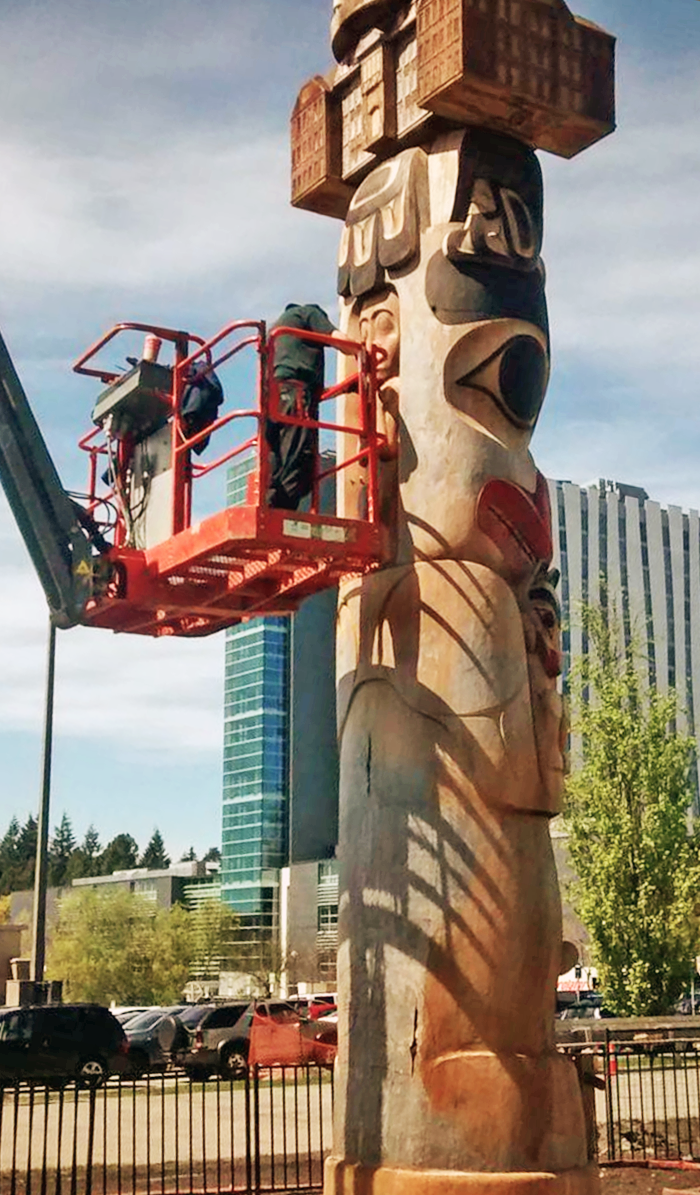
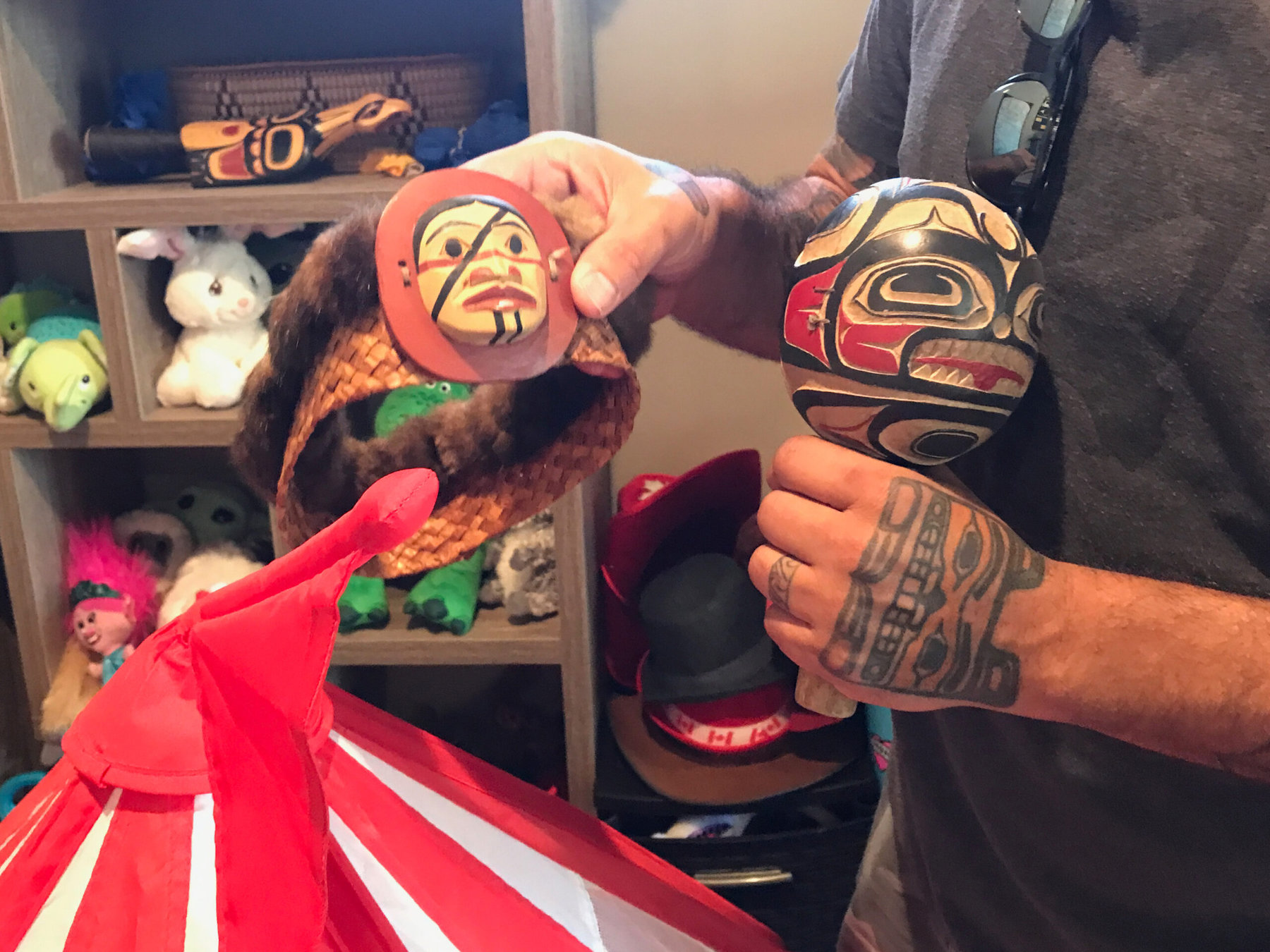
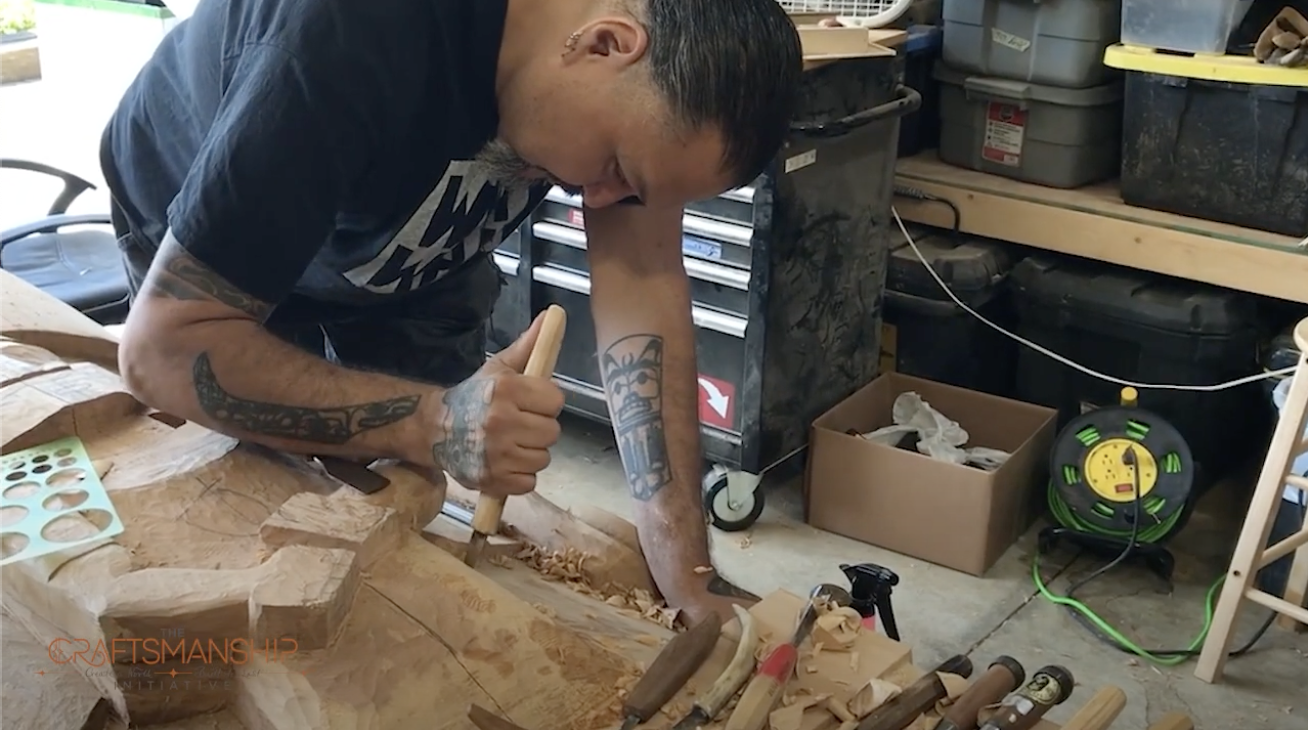
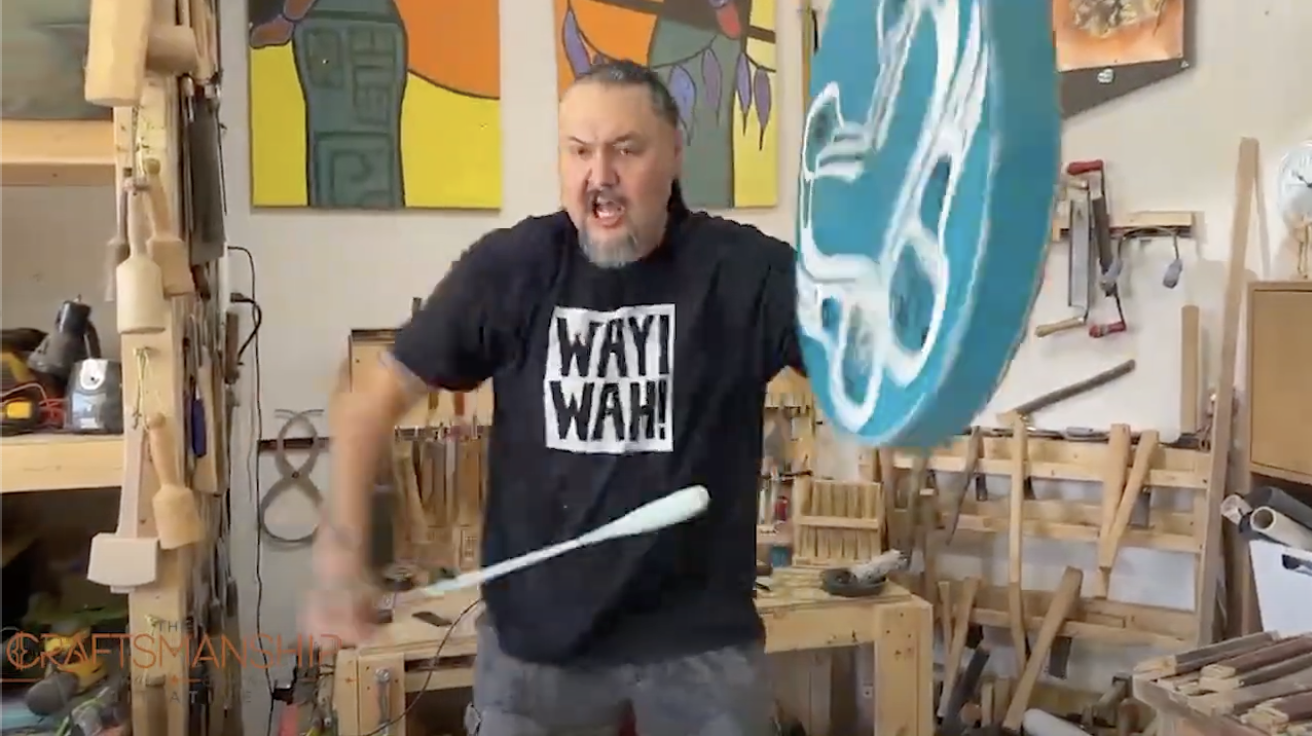





Comments (0)
No reviews found
Add Comment